Vision Quest
Victory’s quest to carve a niche in the highly competitive cruiser market is well documented since the brand launched as a division of Polaris in 1998. After a few years of sputtering and a less-than-aggressive design and development approach, the division revamped and rededicated resources. Seemingly overnight, Victory went from an underachieving company mired in abject blandness to one of the most forward thinking motorcycle makers on the market.
The Victory Vision was the next big step. Maybe it was more of a leap.
Part Gene Autry and part Buck Rogers, the Victory Vision blazes a new styling path that is sure to elicit mixed opinions. 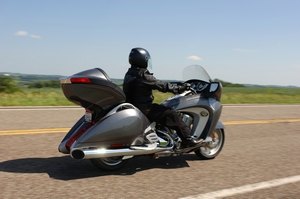
When the ultra-luxury Vision was first conceived several years ago, some pundits may have considered this folly, but the Baby Boomer-dominated cruiser and luxo-cruiser market is only getting older, and old bikers tend to like their creature comforts. Function is good, but it’s not much fun without style. And so after some six years of development, market research, focus groups, top-secret tests, the bulging eyeball scrutiny of Polaris execs, and all the other things bike makers must do to build a breakthrough model, the Vision has finally come to life.
How the new bike should work may have been an easier design decision than what it should look like. The ubiquitous retro profile is nice but getting old and happens to be the undisputed domain of another V-Twin builder from the Midwest, which happens to have a lot of history to draw on. Victory doesn’t have much of a past, even though Polaris has been making one kind of engine or another to stuff into things that slog through mud or snow for more than half a century. And few enthusiasts would want to see a freshened version of an old Victory 92.
So Blackwell and his crew went to the drawing board, that intimidating “blank canvas” that has stymied many an artist and writer and has reduced designers to quivering pools of whining mush. The idea, said Blackwell, was to create broad and lasting appeal, to build a bike that would look good now, and years from now.
This new tourer from Victory is called the Vision, as it’s meant to have a forward-looking style that will still be fresh years from now. Your mileage may vary.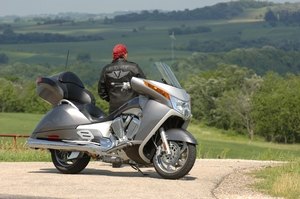
In profile, the Vision’s angular lines look futuristic, from the rear it’s reminiscent of a ’50s Buick, and from the front its wide fairing looks like a bat in flight. So this George Jetson meets James Dean meets Bela Lugosi combines whimsical design elements that may trigger subliminal desires of childhood coolness in the target demographic. Or maybe the designers just thought it was neat.
No matter what the influences, one thing is for sure: the Vision is not your Daddy’s tourer. Equipped with a new 106 cubic-inch engine (1731cc), six-speed transmission and more bells and whistles than most riders can imagine much less expect in a motorcycle, nothing appears left out, including semi-hidden, clever little side bumpers that protect the bike if you drop it. But how does the bike work? Glad you asked.
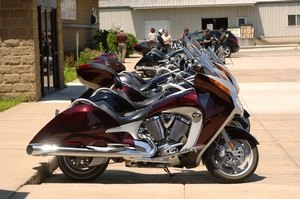 Fresh off the assembly line, the Visions are lined up. Up front in this photo is the Vision Street, the variant that comes without the tail trunk that resides on the Vision Tour. |
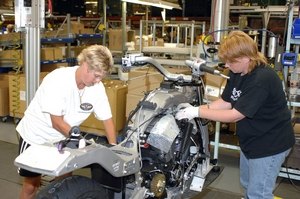 The Vision’s skeleton is on display during assembly at the Victory factory. Note the large cast-aluminum backbone that is claimed to yield a 25% reduction of weight compared to a steel frame. |
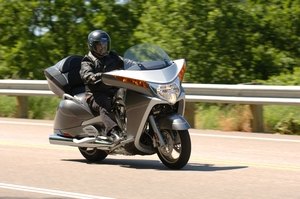 Although the Vision is a visually imposing machine, it is much more nimble than it looks. |
Those are nice numbers, but more impressive is how the power is distributed. The engine was developed to deliver passing power in all gears, including a taller overdrive top gear. It does. There aren’t many bikes on the street that don’t require a downshift in top gear when going to pass a truck or a pesky slowpoke tourist, but this bike chugs along nicely. A shorter first gear makes for responsive low-speed cruising.
The new mill breathes through a new airbox, which isn’t a box at all but more of a scoop built into the new frame (now cast-aluminum instead of steel – Ed.). The 106 motor has a longer stroke than its predecessor for more torque, along with the accompanying new camshafts, pistons, rods, crank, balance shaft, cases and covers. The engine is fired through the 45mm throttle bodies of a new fuel injection system, controlled by a brainier electronic brain (ECM) and assisted by new oxygen sensors and idle air control. A hydraulic clutch was added to make shifts easier on your aging Baby Boomer hand. A belt provides the final drive.
Other improvements include a new cooling system sporting a smaller oil cooler. A new primary drive and torque compensator were added for a quieter, smoother ride. Engineers were so pleased they gave a name, NVH, for any part that reduces noise, vibration or harshness. It’s only a matter of time before it ends up in street lexicon, maybe even a rap song.
While a lot of engineering went into the Vision Tour and Street, the latter of which is mostly a Tour version sans trunk, many customers will be most interested in how comfortable and carefree the bike is. Ergonomics are spot on with an easy reach to the handlebar, four inches of foam on the seat, which sits at an earth hugging 26.5 inches above the asphalt, and long, roomy floorboards. Thankfully, there is no heel shifter, an annoying piece of metal that often gets in the way of my big black boot. The company flogged the press corps on the Vision’s recent media launch, pushing out 400 miles the first day, among other punishing moto-journalist labors, to prove, I suspect, that the bike is indeed an all-day hauler even if it killed us.
The bike’s big fairing and cushy seat left me feeling pretty good by the end of the long day, not that usual beat-up and exhausted sensation that leaves me asking strangers at gas stations and taco stands to rub my butt. Well, it’s an icebreaker, although on this trip I asked a couple of times by, you know, force of habit, but people rudely ignored my request and went straight to admiring the Vision, particularly its artsy V-shaped taillight, which reminded me of something my favorite superhero would wear on his chest. If fuel stops were any indication, the bike is a big hit; but sadly, my butt wasn’t.
Speaking of gas stops, I think the Vision needed a few too many. Under all that plastic skin lays not only all the engine, electrical, and plumbing works, which are not always pretty, but a big, fat six-gallon fuel tank. I guess bikes are just like people; things get a little messy under the skin.
Anyway, the tank is split, flanking the frame and mounted under the fairing far more forward than anything that seems natural to me. I kept imagining the gas sloshing left and right under the steering head as I made turns, and indeed handling felt a little slow. A full range of luxury niceties help make the Vision an accommodating mount for long distances. And its bat-wing front end will appeal to Bruce Wayne. The Victory Vision Tour has the capacious tail trunk that augments the swoopy-but-not-huge saddlebags. The $1000-cheaper Vision Street goes without the hatchback.
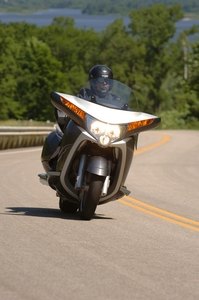
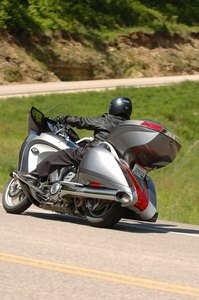
I averaged about 30 mpg in aggressive back road riding, although I couldn’t tell it from the Vision’s electronic mpg digital gauge. This bike has lots of gauges you can toggle to for more input than you’ll probably want, but the accuracy of some seemed questionable during the two days I was aboard. Victory reps assure us new fuel-computing software is being updated from the settings of the first-run production units we tested.
The analog gas gauge seemed not much better as I watched the needle drop with alarming speed. The bike needs to be filled up on its kickstand for it to fill to the top; standing it straight up will leave you riding away with three-quarters of a tank.The Vision comes with speakers to and fro, providing adequate sound quality and plenty of volume. An iPod jack and FM/AM radio are standard; GPS, XM and trunk-stashed CD changer are options. Plugging in an iPod was almost too much fun, practically turning those long floorboards into a dance floor for my happy feet.
Victory created an integrated braking system to haul in the 849-lb. (dry) machine. The dual disc, three-piston front brake and rear single disc, two-piston unit work together. Under mild to heavy rear braking, a “slight degree” of front brake is hydraulically activated for a more controlled stop.
The Vision is suspended on a 43mm fork and a rear air monoshock that can be adjusted via an air valve mounted on the side of the bike. The stock setting provided a cozy ride.
The Vision is built to be your last luxury tourer, a smooth and powerful long-distance machine made with every conceivable comfort and convenience right down to its optional electrically adjustable windshield. But the bike was not without some issues aside from its tricky gauges. The sculpted saddlebags look really cool but offer surprisingly little storage space, although the top trunk (optional on the Street) is roomy enough to hold two full-face helmets, a jacket and a maybe a six-pack.
The mirrors are built into the fairing, which is okay aesthetically, but limits their adjustability. Mostly, I got an excellent view of my gloves. The tank panel and fairing contain lots of buttons controlling lots of things from audio choice to speaker volume to the “O” shaped single running light that sits below the HID headlight, looking like the mouth of some winged beastie. The switches are easy to figure out intuitively in case you hate muddling though manuals, like me. A plain, old-fashioned analog speedo and tach round out the instrumentation. The wingspan of the fairing is broad enough to discourage any kind of lane splitting and looks to be a pretty pricy unit if repair or replacement is ever needed. However, Victory reps purposely tipped over a Vision to demonstrate the protection offered by its integral bumpers, and the bike emerged unscathed.
The factory is expected to begin production late this summer with the first Visions rolling into showrooms later this fall. The Vision Street will carry an MSRP of $18,999; the Tour, $19,999. Option-laden Premium versions of both will be available but prices have not been set. The Vision will come in Midnight Cherry, Super Steel Gray or Black.



Tidak ada komentar:
Posting Komentar